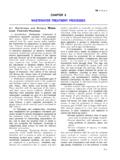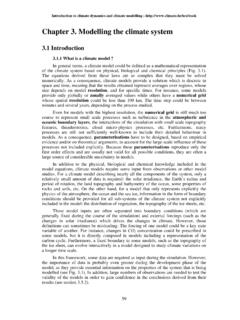Transcription of EVENTS AND PROCESSES
1 SECTION I. EVENTS AND PROCESSES . In Section I, you will read about the french revolution , the Russian revolution , and the rise of Nazism. In different ways all these EVENTS were important in the making of the modern world. chapter I is on the french revolution . Today we often take the ideas of liberty, EVENTS AND PROCESSES . freedom and equality for granted. But we need to remind ourselves that these ideas also have a history. By looking at the french revolution you will read a small part of that history. The french revolution led to the end of monarchy in France. A. society based on privileges gave way to a new system of governance. The Declaration of the Rights of Man during the revolution , announced the coming of a new time. The idea that all individuals had rights and could claim equality became part of a new language of politics. These notions of equality and freedom emerged as the central ideas of a new age; but in different countries they were reinterpreted and rethought in many different ways.
2 The anti-colonial movements in India and China, Africa and revolution South America, produced ideas that were innovative and original, but they spoke in a language that gained currency only from the late eighteenth century. In chapter II, you will read about the coming of socialism in Europe, and the dramatic EVENTS that forced the ruling monarch, Tsar Nicholas II, to give up power. The Russian french revolution sought to change society in a different way. It raised the question of economic equality and the well-being of workers and peasants. The chapter will tell you about the changes that were initiated by the new Soviet government, the problems The it faced and the measures it undertook. While Soviet Russia pushed ahead with industrialisation and mechanisation of agriculture, it denied the rights of citizens that were essential to the working of a democratic society. The ideals of socialism, 2021 22 1.
3 However, became part of the anti-colonial movements in different countries. Today the Soviet Union has broken up and socialism is in crisis but through the twentieth century it has been a powerful force in the shaping of the contemporary world. chapter III will take you to Germany. It will discuss the rise of Hitler and the politics of Nazism. You will read about the children and women in Nazi Germany, about schools and concentration camps. You will see how Nazism denied various minorities a right to live, how it drew upon a long tradition of anti-Jewish feelings to persecute the Jews, and how it waged a relentless battle against democracy and socialism. But the story of Nazism's rise is not only about a few specific EVENTS , about massacres and killings. It is about the working of an elaborate and frightening system which operated at different levels. Some in India were impressed with the ideas of Hitler but most watched the rise of Nazism with horror.
4 The history of the modern world is not simply a story of the unfolding of freedom and democracy. It has also been a story of violence and tyranny, death and destruction. India and the Contemporary World 2 2021 22. chapter I. The french revolution On the morning of 14 July 1789, the city of Paris was in a state of alarm. The king had commanded troops to move into the city. Rumours spread that he would soon order the army to open fire upon the citizens. Some 7,000 men and women gathered in front of the town hall and decided to form a peoples' militia. They broke into a number of government buildings in search of arms. Finally, a group of several hundred people marched towards the eastern part of the city and stormed the fortress-prison, the Bastille, where they hoped to find hoarded ammunition. In the armed fight that followed, R e v o l u t i o n the commander of the Bastille was killed and the prisoners released.
5 Though there were only seven of them. Yet the Bastille was hated by all, because it stood for the despotic power of the king. The fortress was demolished and its stone fragments were sold in the markets to all those who wished to keep a souvenir of its destruction. The days that followed saw more rioting both in Paris and the countryside. Most people were protesting against the high price of bread. Much later, when historians looked back upon this time, they saw it as the beginning of a chain of EVENTS that ultimately led to the execution of the king in France, though most people at the time did not anticipate this outcome. How and why did this happen? F rR e ev o l unt i ocn h T h T eh e french Storming of the Bastille. Soon after the demolition of the Bastille, artists made prints commemorating the event. 2021 22 3. 1 french Society During the Late Eighteenth Century In 1774, Louis XVI of the Bourbon family of kings ascended the throne of France.
6 He was 20 years old and married to the Austrian 1st estate princess Marie Antoinette. Upon his accession the new king found Clergy an empty treasury. Long years of war had drained the financial resources of France. Added to this was the cost of maintaining an extravagant court at the immense palace of Versailles. Under Louis 2nd estate XVI, France helped the thirteen American colonies to gain their Nobility independence from the common enemy, Britain. The war added more than a billion livres to a debt that had already risen to more than 2. 3rd estate billion livres. Lenders who gave the state credit, now began to charge 10 per cent interest on loans. So the french government was obliged Big businessmen, merchants, court to spend an increasing percentage of its budget on interest payments officials, lawyers etc. alone. To meet its regular expenses, such as the cost of maintaining Peasants and an army, the court, running government offices or universities, the artisans state was forced to increase taxes.
7 Yet even this measure would not have sufficed. french society in the eighteenth century was divided Small peasants, landless labour, into three estates, and only members of the third estate paid taxes. servants The society of estates was part of the feudal system that dated back to the middle ages. The term Old Regime is usually used to describe the A Society of Estates. society and institutions of France before 1789. Note that within the Third Estate some were rich and others poor. Fig. 2 shows how the system of estates in french society was organised. Peasants made up about 90 per cent of the population. However, only a small number of them owned the land they cultivated. About 60 per cent of the land was owned by nobles, the Church and other richer members of the third estate. The members of the first two estates, that is, the clergy and the nobility, enjoyed certain privileges by India and the Contemporary World birth.
8 The most important of these was exemption from paying taxes to the state. The nobles further enjoyed feudal privileges. These included feudal dues, which they extracted from the peasants. Peasants were obliged New words to render services to the lord to work in his house and fields to serve in the army or to participate in building roads. Livre Unit of currency in France, discontinued in 1794. The Church too extracted its share of taxes called tithes from the peasants, Clergy Group of persons invested with and finally, all members of the third estate had to pay taxes to the state. special functions in the church These included a direct tax, called taille, and a number of indirect taxes Tithe A tax levied by the church, comprising which were levied on articles of everyday consumption like salt or tobacco. one-tenth of the agricultural produce The burden of financing activities of the state through taxes was borne Taille Tax to be paid directly to the state by the third estate alone.
9 4 2021 22. This poor fellow brings everything, grain, fruits, money, salad. The fat lord sits there, ready to accept it all. He does not even care to grace him with a look.'. Activity Explain why the artist has portrayed the nobleman as the spider and the peasant as the fly. The nobleman is the spider, The more the devil has, the more he wants.'. the peasant the fly.'. The Spider and the Fly. An anonymous etching. The Struggle to Survive revolution The population of France rose from about 23 million in 1715 to 28. million in 1789. This led to a rapid increase in the demand for foodgrains. Production of grains could not keep pace with the french demand. So the price of bread which was the staple diet of the majority rose rapidly. Most workers were employed as labourers in workshops New words whose owner fixed their wages. But wages did not keep pace with Subsistence crisis An extreme situation where The the rise in prices.
10 So the gap between the poor and the rich widened. Things became worse whenever drought or hail reduced the harvest. the basic means of livelihood are endangered This led to a subsistence crisis, something that occurred frequently Anonymous One whose name remains in France during the Old Regime. unknown 2021 22 5. How a Subsistence Crisis Happens Bad The poorest can no harvest longer buy bread Disease epidemics The course of a subsistence crisis. Activity Fill in the blank boxes in Fig. 4 with appropriate terms from among the following: A Growing Middle Class Envisages an End to Privileges Food riots, scarcity of grain, increased In the past, peasants and workers had participated in revolts against number of deaths, rising food prices, increasing taxes and food scarcity. But they lacked the means and weaker bodies. programmes to carry out full-scale measures that would bring about a change in the social and economic order.











